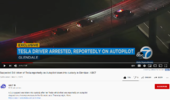The driver first crashed into a road side wall and continued on its way. It's a weird chase after the Autopilot:
1) Police should not slow down an Autopilot the same way as a non-Autopilot one. In the youtube clip, the patrol car was zigzagging in front of the Tesla. Autopilot are trained to recognize the rear of vehicles and to zigzag is to reduce the perfect view of the rear of the vehicle.
2) Majority of the time, Autopilot should be very good at centering a lane but it's interesting to see this particular Model 3 was hugging the left painted solid line of the lane and not centering it.
3) What does the phrase mean: "ABC 7 reported that the Tesla might have been on autopilot when it was finally stopped but CHP could not confirm that."?
The reporter did say that the driver was incapacitated, not able to take control of the vehicle... and praised the autopilot for preventing "a serious accident".
So, is it reasonable to believe the Autopilot was on based on a small video clip?

1) Police should not slow down an Autopilot the same way as a non-Autopilot one. In the youtube clip, the patrol car was zigzagging in front of the Tesla. Autopilot are trained to recognize the rear of vehicles and to zigzag is to reduce the perfect view of the rear of the vehicle.
2) Majority of the time, Autopilot should be very good at centering a lane but it's interesting to see this particular Model 3 was hugging the left painted solid line of the lane and not centering it.
3) What does the phrase mean: "ABC 7 reported that the Tesla might have been on autopilot when it was finally stopped but CHP could not confirm that."?
The reporter did say that the driver was incapacitated, not able to take control of the vehicle... and praised the autopilot for preventing "a serious accident".
So, is it reasonable to believe the Autopilot was on based on a small video clip?




